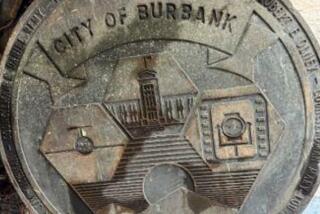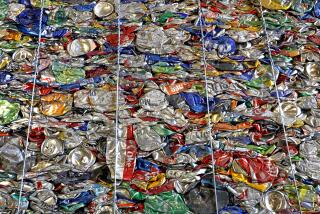THE GOODS : Many Happy Returns : Cutting-Edge Ideas Have Made Burbank’s Recycling Center More Than Just Some Dump
- Share via
Nestled below the I-5 and a ring of mountains, the Burbank Recycle Center, descendant of the humble city dump, looks like an environmentalist’s dream.
From the outside, the cement-block complex with bright blue trim appears tidy as a ship’s deck, despite the constant stream of trucks rumbling through the entrance to empty giant loads of mingled paper, cans and bottles from their curbside collections.
Individual citizens in cars can swing into the courtyard’s buy-back center, deposit household paper, plastic or cans into clearly marked bins, and pick up cash on the way out.
And inside the administration building, a carpeted conference center offers so many exhibits that it is a regular stop for school tours. (On the bulletin board are working sketches for a walk-in simulated compost heap with insects chomping leaves and twigs.) It’s also a popular stop for visiting environmentalists and even business leaders showing off the city.
“We’re a user-friendly place,” said Steve Maggi, recycling coordinator. With recycling specialist Hope McAloon, he led a tour of the sprawling complex at 500 S. Flower St. They discussed their work in the favorite language of recyclers: Pounds and tons and percentages.
In all categories, Burbank excels.
“We’re now recycling 3,000 tons of materials a month,” McAloon said. “Right now we’re diverting 38% of our trash back into circulation in some way. This is up from 25% in 1990.” They expect to hit 50% by the year 2000, Maggi said.
These are figures to envy in California. A 1989 state law, aimed at lessening the landfill burden, mandates that cities must divert 25% of their trash by 1995 or be subject to heavy fines.
While some play catch-up, Burbank is ahead of the game. “Joy Hamilton, now retired, was the administration officer who initiated curbside and buy-back and drop-off in 1982, ahead of most cities,” Maggi said. “She was a visionary.”
And with the facility’s opening in 1992, the city took another forward step.
“It’s a clean, integrated part of the community, not just a business slapped onto the corner trying to make a buck,” said Geoffrey Folsom of Smurfit Recycling, the city’s partner in this venture.
“People who never saw themselves in a million years driving into a recycling center with their family now do it,” he said. “Any Saturday we have people lined up to sell their cans or plastic bottles--we have families with kids, we have limousines and even a few movie stars.”
Smurfit, a division of the Jefferson Smurfit Corp., a giant paper producer and recycler, are experienced brokers with a global network of markets for the tons of material that move through the Burbank center daily.
“It’s the combination of a fairly innovative city with a company that wants to be on the forefront,” Maggi said.
As a result, Burbank was named the best recycler in the nation last year by the American Forest & Paper Assn., which cited the city’s comprehensive program as a national model.
McAloon and Maggi describe the many parts of the program, all dedicated to the philosophy that “Recycling is a lot more than just picking up the trash.”
They include:
* The buy-back/drop-off center, which last year paid out more than $300,000 for paper, cans and bottles citizens brought in. And lots of conscientious recyclers bring in materials that don’t bring money, McAloon said. “We can take items that most recyclers don’t want, including telephone directories and detergent and cereal boxes.”
* Household curbside collections.
* Waste-oil drop-off.
* Monthly pickup of bulky household appliances.
* Back-yard composting, a major factor because yard waste accounts for 30% of most landfills. “Some cities sell compost bins,” McAloon said. “We give them away.”
* “Green waste” program for yard clippings that aren’t composted. “We pick it up and sell it to a contractor who ships it to Kern County for composting,” Maggi said.
* Recycling programs for businesses.
* The City of Burbank’s own in-house program that encompasses both recycling and buying recycled products.
* A Christmas tree program that recycled 100,000 tons of evergreen into compost last year.
* A speaker’s bureau. “We’ll talk to schools, clubs, business organizations--anyone who will listen,” McAloon said.
And there are other creative touches: Public-spirited recyclers can credit the value of their recyclables to an account that aids the homeless.
“We’ve tried to stay on the cutting edge,” Maggi said. Two years ago, the center launched a Recycling Heroes recognition program. The latest recipients’ list illustrates the range of the city’s recycling outreach.
One hero, Shelley Levin Billik, directs a program at Warner Bros. that not only recycles every scrap of paper on the lot, but also recycles scrap metal, wood, toner cartridges, glass, film, video and audio cassettes. The company also tries to buy environmentally sound products, Billik said.
“It’s important to understand recycling is more than separating your discards,” she said. “We really feel very strongly about it and know that with our size, with our volume, we can make a difference.”
Sharing that belief on a personal level is Paul Herman, 87, who started collecting newspapers five years ago to benefit his church and has developed a citywide route. Three times a week he unloads 800 to 900 pounds, and he loves the new center.
“What a difference,” he said. “The old one was terrible--all the bins out in the weather. I understand this is the best one in the United States. I don’t know if that’s right, but I go along with it.”
Maggi likes to hear the praise. “Our old place was just a half-acre with a little office for the cashier. But getting material in is only half the battle. Everything here is marketed and sold--otherwise, we’d just be a dump.”
That’s where the partnership with Smurfit comes in. “Burbank supplies the building, and we’re the contractor,” Folsom said. “We are like a tenant. We pick up all the materials, process them and market the finished product all around the world.”
In the processing plant, a towering open warehouse, mountains of paper, plastic and glass are sorted on a moving belt and dumped into a baler to be crushed and baled into giant cubes, ready for export.
Like any other commodity, recyclables are vulnerable to supply and demand, Folsom said, which is why buy-back prices fluctuate. And although the sudden growth of city recycling programs has overloaded the market with paper, he sees the problem diminishing as the demand for recycled paper grows: “As long as people realize how the whole recycling loop works, the supply we generate as a group will find its natural demand from consumers.”
Although the city doesn’t make a profit from the center, it is considered a successful endeavor, said Sylvia Glazer, Burbank’s administrative officer in public works.
“It’s a good public-private partnership and I think we are innovative in many of our programs,” she said. “The Recycling Center is a very positive place.”
The Exchange Rates
The Burbank Recycle Center pays for these materials; the amount fluctuates anywhere from a third of a penny per pound for colored No. 2 plastic bottles up to 95 cents per pound for aluminum cans bearing California redemption logos:
* Aluminum cans (with or without redemption logo) * Glass bottles and jars * Plastic bottles (No. 1 with redemption logo and No. 2, clear or color without logo) * White or color office paper * Corrugated cardboard * Newsprint * Computer printout paper * Used motor oil
The center also accepts the following materials for recycling but does not pay anything for them: * Aluminum scrap (clean foil, food trays, screens, etc.) * Steel and tin cans * Non-redemption No. 1 plastic * Magazines and catalogues * Telephone books * Non-corrugated cardboard (such as detergent or cereal boxes) * Brown paper bags * Nontoxic aerosol cans
For information, call (818) 953-3152.
More to Read
Sign up for Essential California
The most important California stories and recommendations in your inbox every morning.
You may occasionally receive promotional content from the Los Angeles Times.










